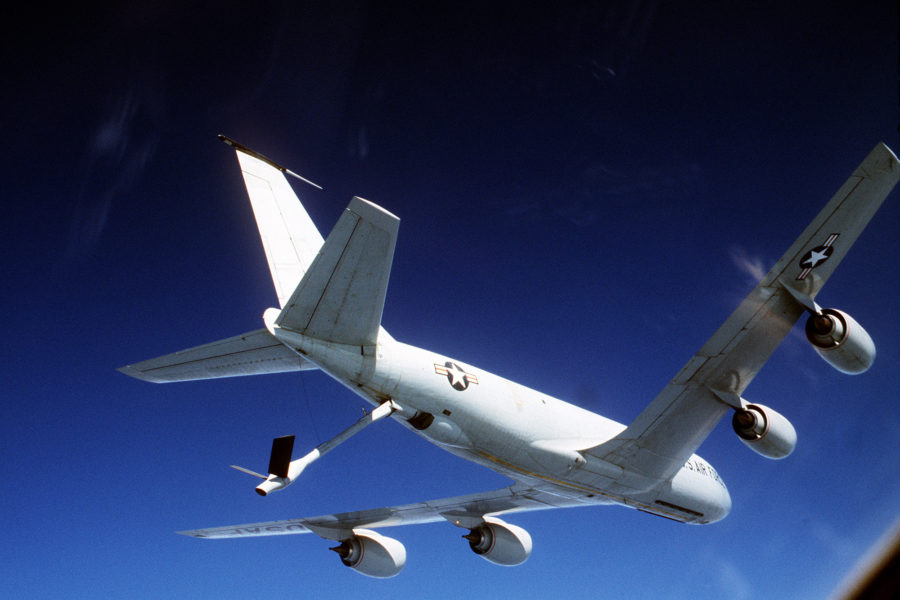The KC-135 is an aerial tanker capable of simultaneous cargo and AE missions and has been the mainstay of the USAF tanker fleet for more than 60 years.
The C-135 family is similar in appearance to the commercial 707 but designed to unique military specifications and first flew on Aug. 31, 1956. The KC-135A fleet was delivered between June 1957 and January 1965, reaching IOC at Castle AFB, Calif., in 1957. KC-135s were re-engined under two separate but concurrent programs and redelivered as the KC-135E and the current KC-135R beginning in July 1984.

Twenty KC-135Rs received Multipoint Refueling System (MPRS) hose/drogue pods on each wing to simultaneously refuel two NATO or Navy aircraft. (Standard KC-135s can use a single drogue adapter attached to the boom).
A small number of McConnell-based aircraft are also receiver-capable, incorporating a forward-fuselage receptacle. KC-135s can be equipped with a podded Large-Aircraft IR Countermeasures (LAIRCM) system to track/jam IR missiles for high-threat missions.
The fleet is undergoing Block 45 cockpit upgrades at a rate of 38 aircraft a year through 2027. Block 45 cockpit mods enhance the modernized PACER CRAG flight deck with an additional glass cockpit display for engine instrumentation, a radar altimeter, advanced autopilot, and modern flight director. Other ongoing upgrades include Aero-I long-distance oceanic satellite tracking/ C2 replacement, and rudder position indicator retrofit. Iridium SATCOM will replace Aero-I fleetwide by 2026, while rudder instrumentation aims to prevent accidents like the fatal 2013 Kyrgyzstan crash.
FY23 launches Mobile User Objective System (MUOS) secure, jam-resistant BLOS and NATO-interoperable LOS SATURN. Two KC-135s were converted to WC135R standards to replace Constant Phoenix in 2022. Congress barred KC-135 cuts to prevent a tanker shortage due to KC-46 delays in FY21 but allowed 18 KC-135s to retire in FY22 followed by 13 in FY23.
Retirements make room for KC-46 beddown at March and McGuire. USAF plans to retain the fleet until at least 2050, but announced plans to possibly pursue a “bridge tanker” to augment KC-46 until a notional Next-Generation Air-Refueling System (NGAS) emerges.
Contractors: Boeing; Rockwell Collins (Block 45).
First Flight: Aug. 4, 1982 (KC-135R).
Delivered: July 1984-June 9, 2005 (KC-135R).
IOC: June 1957.
Production: 732 (420 converted to KC-135R).
Inventory: 224 (KC-135R), 54 (KC-135T).
Operator: AETC, AFMC, AMC, PACAF, USAFE, ANG, AFRC.
Aircraft Location: Altus AFB, Okla.; Beale AFB, Calif.; Fairchild AFB, Wash.; Grissom ARB, Ind.; JB Andrews, Md.; Kadena AB, Japan; MacDill AFB, Fla.; March ARB, Calif.; McConnell AFB, Kan.; RAF Mildenhall, U.K.; Seymour-Johnson AFB, N.C.; Tinker AFB, Okla.; and ANG in Alabama, Alaska (active associate), Arizona, Hawaii, Illinois, Iowa, Kansas, Maine, Michigan, Mississippi, Nebraska, New Jersey, New York, Ohio, Pennsylvania, Tennessee, Utah, Washington, Wisconsin.
Active Variant: •KC-135R. Re-engined KC-135A fitted with CFM turbofan engines. •KC-135T. Reengined former KC-135Qs, able to carry different fuels in wing and fuselage tanks.
Dimensions: Span 130.8 ft, length 136.3 ft, height 41.7 ft.
Weight: Max T-O 322,500 lb.
Power Plant: Four CFM International CFM56-2 (USAF designation F108) turbofans, each 21,634 lb thrust.
Performance: Speed 530 mph at 30,000 ft, range 1,500 miles with 150,000 lb transfer fuel, up to 11,015 miles for ferry missions.
Ceiling: 50,000 ft.
Fuel Capacity: Max transfer load 200,000 lb at 1,100 gpm (boom), 450 gpm (MPRS pods).
Accommodation: Two pilots, navigator, boom operator, AE crew: two flight nurses, three medical technicians (adjusted as needed).
Load: 37 passengers, six cargo pallets, max 83,000 lb.



